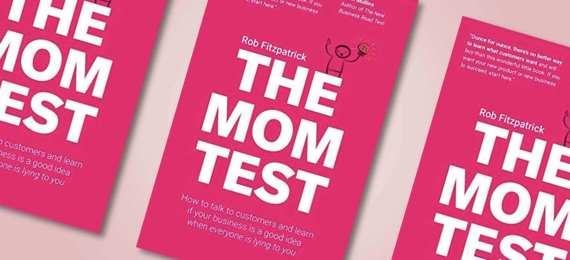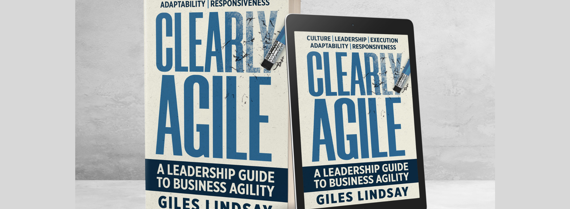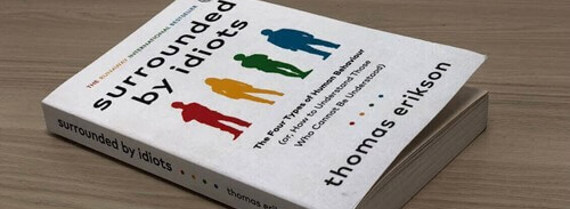
I’ve seen The Mom Test by Rob Fitzpatrick recommended a number of different times by people who work in tech as a book that gives a clear understanding of how to build successful products. Since it's been around for a few years and has managed to hang on to its popularity, I thought I’d cast a critical eye over it and see how well it matches up with a design research approach.
The book aims to show you ‘How to talk to customers and learn if your business is a good idea when everyone is lying to you’ and is described on the back cover as ‘the best and most accessible book for entrepreneurs who are seeking product market fit.’ Given that one of the main things we do at Nightingale is to help companies find and test new ideas, I was curious to find out what Rob had to say.
Why 'moms'?
Rob starts from the premise that entrepreneurs know talking to customers is important, but in spite of that knowledge, many start ups still create products that no one wants. In his opinion one of the key problems is that entrepreneurs ask the wrong people and/or the wrong questions. While I was ready to be annoyed at the stereotypical use of ‘moms’ as people who know nothing (plenty of moms work in tech after all - this mom is an actual factual design researcher and a great person to run ideas by, whether you’re related to me or not), it turns out the mom thing is just a gimmick used to make the point that you should never ask anyone if your business is a good idea, because they won’t tell you the truth - a point I entirely agree with. The book then explores what sort of questions you should ask customers and how you should ask them.
Entrepreneurs as researchers?
Rob makes a lot of excellent points that I agree entirely with - the difficulty of getting at what a customer really means, the fragility of customer insights, the importance of asking the right type of question at the right time - and it’s clear that he understands the subtleties of phrasing and interaction that make a good and bad customer interview. But I couldn’t quite get past the idea, which Rob states and emphasises, that the entrepreneur should be doing all of this research themselves.
There are two difficulties I have with this idea - one, it assumes that the entrepreneur can easily learn enough research skills to get something useful out of these customer conversations and two, it involves the entrepreneur trying to find things out about their own idea in an impartial, objective way.
I have seen entrepreneurs research their own ideas. Even with a very clear script, filled with the right questions, they still go off-piste, explain and justify their idea, object to criticism and unintentionally reveal when they’re upset/annoyed. It’s totally understandable that that happens - very few entrepreneurs are trained researchers and it is very hard to have any sort of objectivity about an idea you are personally invested in.
Rob acknowledges that talking to customers is ‘delicate work’ and that it’s possible to damage insights by digging too hard. While he does give simple, practical and accurate advice about how to ask customer questions, he doesn’t adequately convey how much intricacy and skill is involved in conducting a successful customer interview. The implication, as with many similar books I’ve read, is that research is something anyone can do once they know the basics. In my experience, some people have a talent for interviewing and can get to the core of what a person is saying without much difficulty. But it’s much more common for people to struggle, at least at first, with the subtleties of finding the right question to ask. It takes time and experience to learn how to really listen to what someone is saying and to think on your feet to come up with a question that gets at the core of what they mean.
Making research count
Another difficulty I have with Rob’s approach is that his goal is to help readers ‘learn if your business is a good idea.’ Learning if your business is a good idea is a process I would definitely recommend, but in my world that process first requires detailed desk research to get all the necessary information about the market and the products and solutions that already exist. This initial research can tell you very quickly if your idea might have traction - if you don’t do it, there’s a strong chance you’ll waste time having conversations with customers about a product that has no hope of success. If this initial research goes well, it will identify clearly where your product might fit, both in the market and in the lives of your potential users, and it will show you where the gaps in your knowledge lie - these are the gaps that research with customers needs to fill.
The next stage should involve using what what was learned in your desk research to start delving into the lives of your potential users in order to understand what they need and whether you can deliver it. In my experience, for this research to yield useful insights, it needs to be very carefully planned, with a lot of thought put into who to talk to and which research questions you’re trying to answer. Rob does discuss ways to identify potential customers, but there is very little mention of how to create an overall plan or structure to the various customer conversations. Instead, he advises to keep the conversations casual - they’re presented as something an entrepreneur does when the opportunity arises, by talking to people in various different situations - cafes, events, online. This approach may well pay off, but there’s a distinct danger that the entrepreneur will spend a lot of time having conversations with quite a random array of people, yielding a huge amount of information that’s very difficult to interpret because there’s no plan or focus behind them.
Beware of wasting your time
It is vital to learn if a business is a good idea, so that time, money and effort isn’t wasted chasing a bad idea into a dead end. Talking to people and asking the right questions is the best way to learn. However, the process of digging into an idea, breaking it down and finding evidence that a business can grow from it is a complex one. Done correctly, it can be incredibly revealing and useful, providing huge amounts of rich, meaningful data that sets a business on the right path. Done badly, it can be confusing, misleading and essentially a waste of time.
In principle, it is better for entrepreneurs to talk to people about their product idea than not. But this book doesn’t provide enough detail for people who don’t have research experience to get it right. I am, of course, biased, but I would always advise anyone wanting to research their new idea to avoid doing it themselves and to hire someone who can plan and design detailed, rigorous research.



